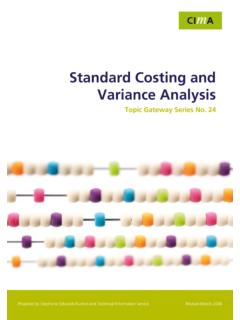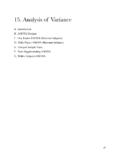Transcription of Variance Swap - frouah.com
1 Variance Swapby Fabrice Douglas this Note we present a detailed derivation of the fair value of variancethat is used in pricing a Variance swap. We describe the approach describedby Demeter et al.[2] and others. We also show how a simpler version can bederived, using the forward price as the threshold in the payo decompositionthat is used in the derivation. The Variance swap has a payo equal toNvar 2R Kvar (1)whereNvaris the notional, 2 Ris the realized annual Variance of the stock overthe life of the swap, andKvar=E[ 2R]is the delivery (strike) Variance . Theobjective is to nd the value ofKvar:1 Stock Price SDEThe Variance swap starts by assuming a stock price evolution similar to Black-Scholes, but with time-varying volatility parameter tdStSt= dt+ tdWt:Considerf(S) = lnSand apply It o s LemmadlnSt= 12 2t dt+ tdWtso that12 2t=dStSt dlnSt:(2)2 The VarianceIn equation (2) take the average Variance fromt= 0tot=TVT=1 TZT0 2tdt=2T"ZT0dStSt ZT0dlnSt#(3)=2T"ZT0dStSt lnSTS0#:1 The Variance swap rateKvaris the fair value of the Variance ; that is, it is theexpected value of the average Variance under the risk neutral measure.
2 HenceKvar=E[VT] =E"1 TZT0 2tdt#(4)=2TE"ZT0dStSt lnSTS0#=2T rT E lnSTS0 :The termdStStrepresents the rate of return of the underlying, so under the riskneutral measure the average expected return over[0;T]is the annual risk freeratertimes the time periodT, namelyrT. Most of the rest of this note willbe devoted to nding an expression forEhlnSTS0i:3 Log ContractThe log contract has the payo functionf(ST) =2T lnS0ST+STS0 1 :(5)Note thatf0(ST) =2T(1S0 1ST)andf00(ST) =2T 1S2T .4 Payo Function DecompositionAny payo functionf(ST)as a function of the underlying terminal priceST>0can be decomposed as followsf(ST) =f(S ) +f0(S )(ST S ) +(6)ZS 0f00(K)(K ST)+dK+Z1S f00(K)(ST K)+dKwhereS >0is an arbitrary threshold. See the Note on fora derivation of equation (6) using three di erent approaches. Apply equation(6) to the log contract (5) to get2T lnS0ST+STS0 1 =2T lnS0S +S S0 1 +2T 1S0 1S (ST S ) +2 TZS 01K2(K ST)+dK+2TZ1S 1K2(ST K)+dK:2 Cancel2 Tfrom both sides and re-arrange the terms to obtain lnSTS = ST S S +ZS 01K2(K ST)+dK+(7)Z1S 1K2(ST K)+dK:This is equation (28) of Demeter et al.
3 [2]. Take expectations on both sidesof equation (7), bringing the expectations inside the integrals where needed E lnSTS = E[ST] S S +(8)ZS 01K2E (K ST)+ dK+Z1S 1K2E (ST K)+ dK= S0S erT 1 +erTZS 01K2P(K)dK+erTZ1S 1K2C(K)dKwhereP(K) =e rTE[(K ST)+]is the put price,C(K) =e rTE[(ST K)+]is the call price, and whereE[ST] =S0erT=FTis the time-Tforward price ofthe underlying at time zero when the underlying price isS0. Now writelnSTS0= lnSTS + lnS S0which implies that E lnSTS0 = lnS S0 E lnSTS :(9)Substitute equation (8) into (9) to obtain E lnSTS0 = lnS S0 S0S erT 1 +(10)erTZS 01K2P(K)dK+erTZ1S 1K2C(K)dK:5 Fair Value of VarianceRecall equation (4) for the fair valueKvar=2T rT E lnSTS0 :(11)3 Substitute equation (10) for EhlnSTS0ito obtain the fair value of Variance atinception, namely, at timet= rT S0S erT 1 lnS S0+(12)erTZS 01K2P(K)dK+erTZ1S 1K2C(K)dK)This is equation (29) of Demeter et al.
4 [2].6 Fair Value Using Forward PriceSometimesKvaris written in a simpli ed form. To see this, let the thresholdS in equation (12) be de ned as the forward price,S =S0erT=FT. Aftersome minor algebra, we arrive atKvar=2 TerT(ZFT01K2P(K)dK+Z1FT1K2C(K)dK):(13)7 Mark-to-Market Value of a Variance SwapIn this section we use the notation of Jacquier and Slaoui [6]. At inceptionof the Variance swap, the swap strike is set to the expected value of the futurevariance, so the swap has value zero. Going forward, however, the value of theswap can become non-zero. To see this, rst denote the denote the averageexpected Variance over the time interval(t;T)asKt;Tvar=1T tEt"ZTt 2udu#whereEt[ ]denotes the expectation at timet. At inception (t= 0) we writeK0;Tvar=1TE"ZT0 2udu#which isKvarthat appears in equation (4), (11), (12), and (13), the value atinception of the Variance swap strike.
5 The value at timetof the Variance swapstrike, denoted t, is the time-texpected value t=e r(T t)Et"1 TZT0 2udu K0;Tvar#:(14)4At inception this expected value is zero, but at timetit is not necessarily write equation (14) by breaking up the integral, which produces t=e r(T t)Et"tT 1tZt0 2udu+T tT 1T tZTt 2udu K0;Tvar#(15)=e r(T t)(tT 20;t+T tTEt"1T tZTt 2udu# K0;Tvar)=e r(T t) tT 20;t+T tTKt;Tvar K0;Tvar =e r(T t) tT 20;t K0;Tvar +T tT Kt;Tvar K0;Tvar where 20;t=1tRt0 2uduis the realized Variance at timet, which is known. Thelast equation in (15) for tis one that is often encountered, such as that whichappears in Section of Flavell [3], for example. It indicates that the time-tmark-to-market value of the Variance swap tis a weighted average of twocomponents1. The term 20;t K0;Tvar, which represents the "accrued value" of the vari-ance swap.
6 Indeed, this is the realized Variance up to timetminus thecontracted The termKt;Tvar K0;Tvar, which represents the di erence in fair strikes cal-culated at time0, and calculated at , at timet, to obtain t, we need to calculateRt0 2udu, which involvesonly Variance that has already been realized. We also need to calculateKt; the same way that equations (12) or (13) are used with options of maturityTto obtainK0;Tvar, those same equations can be used with options of maturity(T t)to obtainKt;Tvar:8 Constant Vega of a Variance SwapExhibit 1 of Demeter et al. [2] shows that a portfolio of options weightedinversely by the square of their strikes has a vega which becomes independentof the spot price as the number of options increases. This can be demonstratedby setting up a portfolio of weighted optionsCde ned as =Z10w(K)C(S;K; )dK(16)wherew(K)is the weight associated with the options andC(S;K; )are theirBlack-Scholes prices.
7 This portfolio is similar to that appearing in equation(13). However, since we are concerned with vanna, which is identical for callsand puts, we do not have to split up the portfolio into calls and puts either will5do. This implies that we can de neC(S;K; )to be either calls or puts, andwe don t need to split up the integral in equation (16) into two integrals. Toexplain their Exhibit 1, Demeter et al. [2] demonstrate that the vanna of theportfolio, namely@2 @ @S, is zero only when the weights are inversely Vega of the PortfolioThe Black-Scholes vega@C@ is identical for vanilla calls and puts so the vega ofthe portfolio isV =@ @ =Z10w(K)@C(S;K; )@ dK:(17)The Black-Scholes vega of an individual option is@C@ =pT2 p2 Sexp 12d21 whered1=1 pT ln(x) +12 2T andx=K=S. Hence we can write equation(17) asV =pT2 p2 Z10w(K)Sexp 12d21 dK:Change the variable of integration tox.
8 Hencedx=1 SdKso thatdK=Sdxand we can writeV =pT2 p2 Z10w(Sx)S2exp 12d21 dx:(18)In this last equation,d1depends onxonly. Hence when we di erentiateV withrespect toSwe only need to di erentiate the termw(Sx)S2. This derivativeis, by the chain rule@@S S2w(Sx) = 2S w(Sx) +S2 @ Vanna of the PortfolioSubstituting equation (19) into (18) and di erentiating with respect toS, thesensitivity of the portfolio vega toSis@2 @ @S=@V @S=pT2 p2 Z10S 2w(Sx) +Sx@w(Sx)@S exp 12d21 dx:The term inside the square brackets can be written2w(Sx) +Sx@w(Sx)@S= 2w(K) +K@w(K)@K:6 Requiring that@V @S= 0implies that2w+K@w@K= 0, or thatw0= 2wK. Thesolution to this di erential equation isw(K)/1K2:Hence, when the weights are chosen to be inversely proportional toK2, theportfolio vega is insensitive to the spot price so that its vanna is zero.
9 This isillustrated in the following gure, which reproduces part of Exhibit 1 of Deme-ter et al. [2]. A portfolio of calls with strikes ranging from $60 to $140 inincrements of $10 is formed, and the Black-Scholes vega of the portfolio is cal-culated by weighing each call equally (dotted line) and by1=K2(solid line).The interest rate is set to zero, the spot price is set to $100, the maturity is 6months and the annual volatility is 20%.2040608010012014016018002468101214 Stock PricePortfolio VegaWeighted by inverse strikeEqually weightedThe vega of the equally-weighted portfolio (dotted line) is clearly not constantbut increases with the stock price. The vega of the strike-weighted portfolio,on the other hand, is at in the $60 to $140 region, which indicates that itsvanna is zero Volatility SwapThis is a swap on volatility instead of on Variance , so the payo isNvol( R Kvol)(20)whereNvolis the notional, Ris the realized annual volatility, andKvolisthe strike volatility.
10 The values ofNvolandKvolcan be obtained by writingequation (20) asNvol( R Kvol) =Nvol 2R K2vol R+Kvol Nvol2 Kvol 2R K2vol :(21) Naive Estimate of Strike VolatilityComparing the last term in equation (21) with equation (1), we see thatNvol2 Kvol=NvarandKvar=K2volfrom which we obtain the naive estimatesKvol=pKvarandNvol= Vega Notional and ConvexityThe payo of a volatility swap is linear in realized volatility, but the payo of a Variance swap is convex in realized volatility. The notional on volatility,Nvolis usually called vega notional. This is becauseNvolrepresents the changein the payo of the swap with a 1 point change in volatility. This is bestillustrated with an example. Suppose that the Variance notional isNvar=$10;000, and that the fair estimate of volatilty is25, so that the Variance strikeisKvar= 252.







